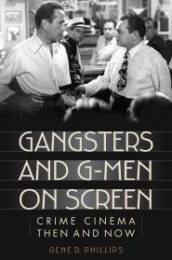When the first (real) talking movie was introduced in 1928 (Lights of New York) it was a gangster movie. The use of gangster lingo, and the sound of gunshots made the genre even more successful. The short, brisk exchanges of the underground characters added more to the illusion of authenticity; the first full-length gangster movie Regeneration (1917, by Raoul Walsh) could not offer sound yet.
 Phillips carefully shows the slow development of the gangster and his antagonists in (mostly) American film history. The journey starts in 1912 with The Muskateers of Pig Alley and ends with Chinatown (1974) and Gangster Squad (2013).
Phillips carefully shows the slow development of the gangster and his antagonists in (mostly) American film history. The journey starts in 1912 with The Muskateers of Pig Alley and ends with Chinatown (1974) and Gangster Squad (2013).
The very early gangster characters from the first wave of sound films of the 1930s were far from being completely fictional; instead, they were loosely based on real-life criminals and hoodlums from the 1920s.
And many of the gangster movies portrayed in the book are actually film noir classics; but mind you, not all films noir therefore are gangster movies.
Gene D. Phillips has already published widely about film, in 2010 he introduced his Out of the Shadows, reviewed right here.
By now, the gangster movie genre is 100 years old and still changes, according to the requirements of the times and the expectations of the audiences. And while back in the 1930s and 1940s moviegoers could easily tell the good guys from the bad ones (one of the many requirements to escape censorship in the US) it became more and more difficult to tell in the following years, particularly when movie cops used the same amount of violence as the criminals and when officials and politicians were committing atrocities even worse than those of the gangsters.
Nevertheless, the torn characters of the gangsters and then later the crime fighters with ambivalent features already were present in the very ancient gangster movies.
Gangsters and G-Men on Screen is a brief anthology of some of the major gangster movies, together with a short plot synopsis and a little extra information on production, original story, shooting location and directors. It is not a bad book, but actually in the thirteen chapters I would have appreciated some additional information on how, for example, the pulp and hardboiled novel had a direct influence on the films and maybe a somewhat longer chapter as to why the genre is still so successful.
For film collectors and movie buffs this book that reviews 24 films (and mentions some more) will hardly cover new grounds or reveal secrets of any kind. For newcomers to the genre, however, it is a good introduction.
Review by Dr. A. Ebert © 2015
Gene D. Phillips. Gangsters and G-Men on Screen: Crime Cinema Then and Now. Rowman & Littlefield, 2014, 204 p.
